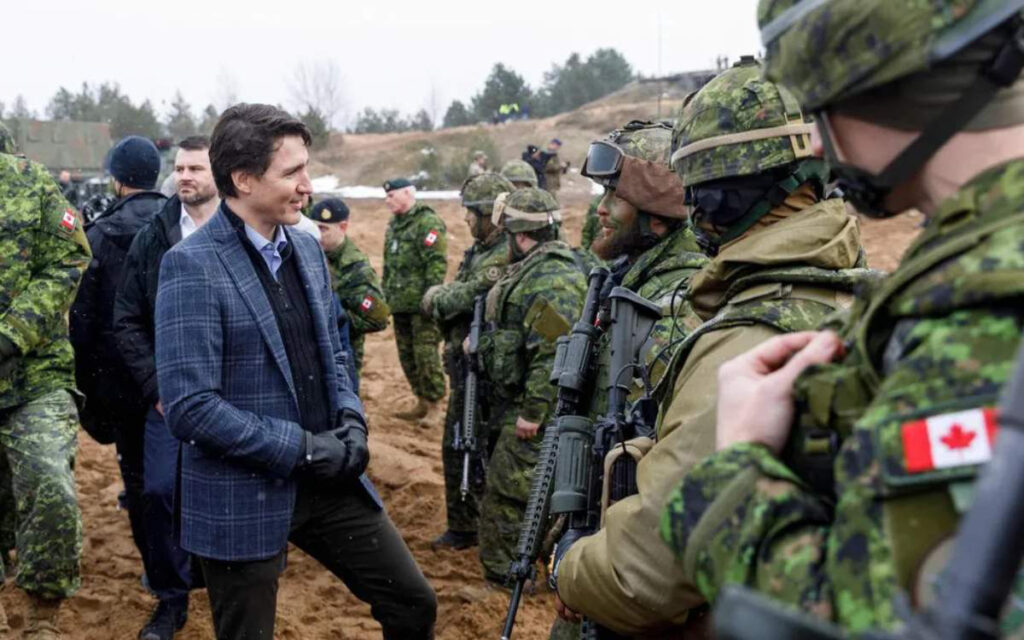
The debate intensifies as NATO Secretary General Jens Stoltenberg urges Canada to provide a concrete timeline for meeting the spending target. Stoltenberg emphasizes the importance of demonstrating intent and commitment to collective security. Photo Credit: AFP/Toms Norde via Getty Images.
If money talks, then Canada is pretty quiet about national defence. While some of our allies in NATO, the North Atlantic Treaty Organization, are looking for Canada, and other countries, to make some noise and step-up to the plate around defence spending.
First at bat to field questions on Canada’s defence policy was the federal Conservative leader, Pierre Poilievre, who, when asked about Canada’s commitment to NATO, took a big swing and looked to hit a home run on the first pitch. Well, at least in the eyes NATO.
In a bid to strengthen Canada’s commitment to Canada’s defence allies, last week Poilievre pledged to meet the alliance’s target of spending two percent of the country’s GDP on defense. Though ambitious and well received in the defence community, his comments come with challenges and controversies, particularly regarding the proposed cuts to foreign aid and the potential impact on social programs.
Canada currently stands as the only NATO member without a concrete plan or timeline to achieve the two percent spending target, according to the U.S. ambassador to NATO, Julianne Smith. Poilievre’s commitment aims to address this gap, but it raises concerns about the allocation of resources and the repercussions for Canada’s commitments elsewhere on the international scene.
Known for his focus on cost of living, Poilievre is positioning himself against Prime Minister Justin Trudeau’s approach, which relies on the U.S. for protection. The Conservative leader asserts that Canada must take charge of its own defense and not depend on foreign powers.
To fulfill the two percent commitment, the Conservative leader suggested that his government would reallocate funds from what he deems “wasteful foreign aid” and back into Canada’s military. However, the specifics of which countries or programs would face cuts remain unspecified.
For Canada, the broader challenge lies in nations’ overall defense spending, which currently falls just shy of 1.3 percent of its GDP. Meeting the two percent target would require a significant increase in the military budget, estimated at around $20 billion annually. Poilievre aims to achieve this by reforming defense procurement, cutting bureaucracy, and targeting defense contractors. Which, on a good day, would be hard to do.
The Department of National Defence currently operates with a budget of approximately $26.5 billion, set to increase to almost $40 billion by 2026-27. A substantial portion of the current budget is allocated to long-term spending commitments such as the purchase of new fighter jets, which Canada is in despite need of as our current planes are on their last legs.
The debate intensifies as NATO Secretary General Jens Stoltenberg urges Canada to provide a concrete timeline for meeting the spending target. Stoltenberg emphasizes the importance of demonstrating intent and commitment to collective security.
Trudeau and his government are facing their own challenges with meeting NATO’s targets as money is becoming tighter and tighter. The government is facing rising deficits, higher interest rates and has committed to reining in spending. As Budget 2024 is on the horizon, it is unlikely that defence will see a major bump in funding as the government looks to curve their spending habits while still fulfilling the needs of Canadians.
For Poilievre, he can enjoy the benefits of being in opposition for now and make grand promises, like meeting NATO’s targets, without having to worry about implementation. His commitment to Canada’s military is noble and one that should be commended, but the challenge for him going forward is defining what is and isn’t “wasteful foreign aid.” What is wasteful to one person is a necessity to another.
It is a tough road ahead for Canada. Meeting the two percent target will require some type of sacrifice, including cuts, possible tax increases or simply ignoring NATO and hoping the status quo will be acceptable going forward.
No matter the answer, the Liberals and Conservatives must articulate their plans and address the inevitable pain that comes with such a significant policy shift. The era of deferring and delaying is over, and Canada’s approach to defense spending must be addressed or face being left out in the cold by our allies.

Daniel Perry is a Senior Consultant with Hill & Knowlton, Canada’s leading public relations and public affairs firm. He is an experienced campaigner and has provided political advice at all levels of government. Daniel has received a number of awards during his career including being voted Ottawa’s top consultant by his peers.




















